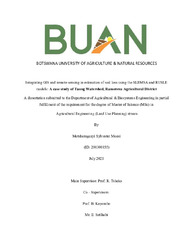Integrating GIS and remote sensing in estimation of soil loss using the SLEMSA and RUSLE models: A case study of Taung Watershed, Ramotswa Agricultural District
Abstract
This study was conducted in the Taung watershed of the Ramotswa Agricultural District in the south eastern part of Botswana. The main objective of this study was to assess the soil erosion risk using Revised Universal Soil Loss Equation (RUSLE) and Soil Loss Estimation Model for Southern Africa (SLEMSA) integrated with Remote Sensing (RS) and Geographical Information System (GIS). The rate of soil loss was determined using rainfall, topography, soil and land use/land cover (LULC) data within the RUSLE and SLEMSA framework. The estimated mean annual soil loss averaged 12.04 t/ha/year in 2000 and 12.74 t/ha/year in 2020 for the RUSLE model. The SLEMSA model estimated the mean annual soil loss of 11.77 t/ha/year in 2000 and 12.57 t/ha/year in 2020. It is evident that soil erosion increased over the years (2000-2020). The predicted soil loss using the two models for Taung watershed was slightly above the recommended limits of 11 ton/ha/year. The results indicate that up to 30.5% of the watershed experiences high soil loss above 12 tons/ha/year when using the RUSLE model and about 43.5% for SLEMSA. It is recommended that conservation efforts should focus on areas with high soil loss as indicated by both models as they form a reasonably large proportion of the study area (covering 23% in RUSLE and 33% in SLEMSA). Furthermore, the findings from this study may be useful to guide the development of a functional soil conservation planning and watershed management plan for the Taung watershed.
Collections
- Theses and Dissertations [133]

